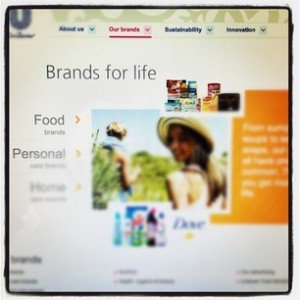Our concept of “Brandscaping” encourages complementary brands to unite in order to amortize content creation costs and realize greater reach through multiple points of distribution.
What about the companies that produce a varied assortment of products, like Unilever or P&G? How can those companies brandscape across products and categories within their own walls?
Internal organizational structure must promote cross-product-pollination
Often in large multi-national companies, each product has a siloed team of people working to merchandise, market, promote, price, and further develop that one particular product. The team functions as its own small internal company, calling on additional resources when needed, but tasked with the responsibility of the P&L for that product. Many companies have applied a structure that allows for quicker time to market for innovative and new products, but what about the ones on the shelves for years?
“Our profile of growth reflects the strategic choices we are making to concentrate spending behind brands that have the most strategic potential for growth.”
— Paul Polmen, Unilever CEO
What if “weaker” Unilever brands could align with stronger ones to push them along?
Companies must place a priority on cross-product teamwork with specific goals (decrease marketing dollars, increase ad reach, etc.) in order for any co-branded efforts to be effective. Forward thinking companies with an eye toward adaptability and flexibility will realize the benefits of a more integrated team across all brands.
Brands must complement and not cannibalize
Once the internal organizational structure is in place to facilitate a successful campaign, the next obvious step is to determine the right brands that can work together without cannibalizing market share for any individual brand. For example, I would not suggest a P&G brandscape that included both Downy and Bounce, as both serve basically the same purpose, and the two together do not offer something more distinctive.
P&G did put together a great commercial with both Bounce & Old Spice included. These brands complement each other, they do not steal market share, and they work well together in this context. They built on the idea by also aligning Charmin with Old Spice.
Could Unilever create a campaign all about getting closer and use Axe, Dove, Close-Up and bring in Match.com? Well, it’s not always as simple as that.
Core values must play a role in how brandscapes are built
Axe, Dove, and Close Up each have different core values. Axe is very much about adventure and excitement, Close Up about advanced technology in oral care, and Dove is about beauty from the inside out. So, although the brands are not in conflict, they are also not well positioned to appeal to the shared values of any singular audience. Surf and Signal both align on wanting to make whatever they touch (dirty clothes or dirty mouth) shine as white as can be. Dig a bit deeper with that shared message and Unilever may have a way to market both brands more efficiently.
Understanding the buyers, the influencers, and users
Finally, not only do brands need to determine that they are complementary, but they also must determine their purchasing target. Consumer brands can market to the end user of the product, the influencer, or the purchaser (among many others). With the Old Spice and Bounce ad, I’d venture to guess that the female buys the laundry products and influences, if not also purchases, male beauty supplies.
Knowing audience segments within the target audience will help brands to choose the right partner publisher, expert talent, and overall message for their self-created brandscape.
Task of the Day
Review the Unliver and P&G portfolio of brands. Can you create a brand alliance within each company, and what expert do you think marries well to the core value of the alignment?
